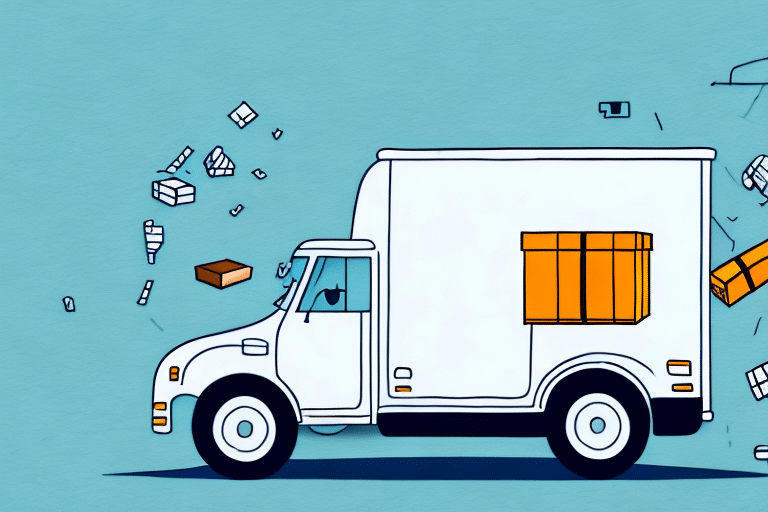The Benefits of 2-Day Shipping for Ecommerce Merchants and Delivery Services
In recent years, 2-day shipping has become the new standard for ecommerce delivery. With busy lifestyles and instant gratification expectations, consumers are demanding faster deliveries, and businesses are taking notice. In this article, we will explore why 2-day shipping has become a game changer for ecommerce and delivery services, its impact on consumer expectations, the technology behind it, and how businesses can successfully implement 2-day shipping programs to increase sales and revenue while improving customer satisfaction.
Why 2-Day Shipping is a Game Changer for Ecommerce
2-day shipping is a game changer for ecommerce for several reasons. First, offering 2-day shipping can give online businesses a competitive edge in their industry. Consumers are likely to choose a seller that offers faster shipping times over a competitor with slower shipping, even if the prices are slightly higher.
In addition, 2-day shipping can help businesses stand out in a saturated marketplace. With so many online sellers competing for consumer attention, offering faster shipping times can help businesses capture more sales and revenue. Finally, 2-day shipping can help businesses build credibility and trust with their customers, which can boost brand loyalty and repeat sales, ultimately driving long-term growth.
Another advantage of 2-day shipping is that it can improve customer satisfaction. Customers are more likely to be satisfied with their purchase if they receive it quickly and on time. This can lead to positive reviews and word-of-mouth referrals, which can attract new customers to the business.
Moreover, 2-day shipping can also help businesses reduce their shipping costs in the long run. By partnering with a reliable shipping carrier and optimizing their shipping processes, businesses can reduce the time and resources required to fulfill orders, leading to cost savings and increased profitability.
How 2-Day Shipping Can Increase Sales and Revenue for Online Businesses
Offering 2-day shipping can give businesses a competitive edge and improve their chances of making a sale. By providing faster delivery options, businesses can reduce cart abandonment rates and increase conversion rates. According to a study by MetaPack, 96% of consumers consider fast delivery important when making online purchases.
Additionally, 2-day shipping can lead to increased revenue for businesses. Faster shipping times can encourage customers to purchase more items at a higher price point to justify the faster shipping cost. Businesses can also charge a premium for expedited deliveries, which can enhance profit margins while boosting customer satisfaction.
Another benefit of offering 2-day shipping is improved customer loyalty and retention. When customers receive their orders quickly and efficiently, they are more likely to return to the same business for future purchases. This can lead to a loyal customer base that generates repeat business and positive word-of-mouth advertising.
The Rise of 2-Day Shipping: A Look at Consumer Expectations
The rise of 2-day shipping is driven by evolving consumer expectations. According to a study by Deloitte, 54% of consumers expect their purchases to arrive in two days or less. This expectation has intensified with the proliferation of subscription-based services like Amazon Prime, which offer free, fast shipping.
As a result, online sellers are under pressure to meet these expectations or risk losing business. Many businesses have responded by partnering with delivery services to offer faster shipping times, while others have developed their own logistics infrastructure to support quicker delivery.
However, the increase in 2-day shipping has also raised environmental concerns. Faster shipping often requires more fuel and resources, leading to increased carbon emissions and waste. Some companies are addressing these concerns by implementing sustainable shipping practices, such as using electric vehicles or optimizing delivery routes to reduce fuel consumption.
The growing popularity of online shopping has further intensified the competition to offer fast and convenient shipping options. Innovations such as same-day delivery and in-store pickup are emerging as retailers seek to differentiate themselves and meet the evolving needs of their customers.
How Delivery Services are Adapting to Meet the Demand for Faster Shipping
Delivery services are evolving to meet the demand for faster shipping times. Many carriers are investing in new technology and infrastructure to ensure quicker deliveries. For example, carriers are implementing dynamic routing to optimize delivery routes, investing in autonomous delivery vehicles, and exploring the use of drones for deliveries in hard-to-reach areas.
In addition, many carriers are expanding their network of warehouses and fulfillment centers to enable same-day and next-day deliveries. Companies like Amazon have significantly increased their distribution centers to support faster delivery options for their customers.
Flexible delivery options are also becoming more prevalent. Many carriers now offer same-day or next-day delivery for an additional fee, as well as the option for customers to choose specific delivery time windows. This allows customers to receive their packages at a convenient time, enhancing the overall delivery experience.
Alternative delivery methods, such as lockers and pickup points, are being experimented with by some delivery services. These options allow customers to collect their packages from designated locations, which is especially convenient for those who are not home during the day or reside in areas with high package theft rates.
The Role of Technology in Making 2-Day Shipping Possible
Technology has been pivotal in enabling 2-day shipping. The rise of ecommerce necessitated efficient order processing and fulfillment, leading to the development of warehouse management systems, transportation management systems, and other software solutions designed to streamline these processes.
Advancements in last-mile delivery technology have also been crucial. GPS tracking and route optimization software help carriers navigate delivery routes more efficiently, while delivery robots and drones facilitate deliveries in challenging areas, reducing delivery times and costs.
Predictive analytics plays a significant role in faster shipping by analyzing data on customer behavior, shipping patterns, and inventory levels. This allows businesses to anticipate demand and adjust their shipping processes accordingly, leading to quicker order processing and fulfillment.
Moreover, technology has enhanced visibility and transparency throughout the shipping process. Real-time package tracking provides customers with updates on their delivery status and estimated arrival times, offering peace of mind and allowing businesses to identify and address any issues promptly.
The Cost-Benefit Analysis of Offering 2-Day Shipping for Ecommerce Merchants
While offering 2-day shipping can be a powerful tool for ecommerce businesses, it comes with associated costs. Shipping expenses can accumulate quickly, especially for small businesses with tight profit margins. Additionally, businesses may need to invest in new technology and infrastructure to support faster shipping times.
However, the benefits of offering 2-day shipping often outweigh the costs, particularly for businesses that prioritize customer satisfaction and loyalty. As discussed, 2-day shipping can increase sales and revenue, reduce cart abandonment rates, and improve customer satisfaction and retention.
Another critical factor is the impact on brand reputation. In today’s fast-paced world, customers expect quick and efficient delivery of their purchases. By offering 2-day shipping, businesses can meet these expectations and establish their brand as reliable and trustworthy. This can lead to positive word-of-mouth marketing and increased brand awareness, ultimately driving more sales and revenue.
The Impact of 2-Day Shipping on Customer Loyalty and Retention
2-day shipping significantly influences customer loyalty and retention. Customers who receive their orders quickly and reliably are more likely to be satisfied with their purchase and develop a positive view of the business. This positive experience can lead to repeat purchases, increased loyalty, and brand advocacy.
Additionally, customers who receive their orders promptly are less likely to cancel their orders or request refunds, reducing the number of returns and chargebacks for businesses. This helps improve the bottom line and maintain healthy cash flow.
Offering 2-day shipping also provides businesses with a competitive edge in the market. With the rise of e-commerce, customers have come to expect fast and reliable shipping options. By meeting these expectations, businesses can stand out from their competitors.
Furthermore, 2-day shipping can help businesses attract new customers. Customers who are hesitant to make online purchases due to concerns about shipping times may be more likely to buy from a business that offers fast and reliable shipping options. This can help expand the customer base and increase revenue.
Best Practices for Implementing a Successful 2-Day Shipping Program
To implement a successful 2-day shipping program, businesses should focus on several key best practices:
- Partner with Reliable Carriers: Collaborate with carriers that can guarantee fast and dependable deliveries.
- Develop Robust Logistics Infrastructure: Invest in warehouse management systems and transportation management systems to support faster shipping times.
- Set Clear Customer Expectations: Clearly communicate shipping times, cutoff times for orders, and estimated delivery dates to customers.
- Offer Incentives: Consider offering free shipping for orders above a certain amount to encourage larger purchases and justify the cost of 2-day shipping.
- Optimize Fulfillment Processes: Ensure that orders are picked, packed, and shipped quickly and accurately by streamlining fulfillment operations.
Overcoming the Challenges of 2-Day Shipping: Logistics, Fulfillment, and Inventory Management
While 2-day shipping offers numerous benefits, it also presents challenges related to logistics, fulfillment, and inventory management. Businesses must be prepared to address these challenges to ensure the success of their 2-day shipping programs.
Inventory Management: Develop strategies to manage inventory effectively, ensuring sufficient stock levels to support faster delivery times.
Fulfillment Optimization: Streamline fulfillment processes to ensure orders are processed quickly and accurately. This may involve automating certain tasks or improving workflow efficiency.
Logistics Infrastructure: Enhance logistics infrastructure by partnering with multiple carriers, expanding the network of warehouses and fulfillment centers, or investing in last-mile delivery technology to ensure timely and efficient deliveries.
Concluding Thoughts
2-day shipping has become the new standard for ecommerce delivery, and businesses that don't offer faster shipping times risk losing sales and customer loyalty. Offering 2-day shipping can help businesses achieve a competitive edge, increase sales and revenue, and improve customer satisfaction and retention.
To implement a successful 2-day shipping program, businesses should partner with reliable carriers, develop a robust logistics infrastructure, and optimize their fulfillment and inventory management processes. By doing so, businesses can meet the growing demand for faster delivery times, drive growth, and improve their bottom line.




















